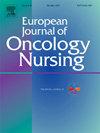Navigating specific targets of breast cancer symptoms: An innovative computer-simulated intervention analysis
IF 2.7
3区 医学
Q1 NURSING
引用次数: 0
Abstract
Purpose
To pinpoint optimal interventions by dissecting the complex symptom interactions, encompassing both their static and temporal dimensions.
Methods
The study incorporated a cross-sectional survey utilizing the MD Anderson Symptom Inventory. Participants with breast cancer undergoing chemotherapy were recruited from the “Be Resilient to Breast Cancer” from April 2023 to June 2024. Static symptom interrelationships were elucidated using undirected and Bayesian network models, complemented by an exploration of their dynamic counterparts through computer-simulated interventions.
Results
The study included 602 patients with breast cancer. Both undirected networks and computer-simulated interventions concurred on the symptoms of distress and fatigue as optimal alleviation targets. The Bayesian network and computer-simulated interventions both emphasized “shortness of breath” as preventive care. Notably, Distress appeared to be the most effective target for interventions, and compared to fatigue (decreasing score = 1.84–2.20, decreasing prevalence = 14.2–16.7%). Conversely, disturbed sleep, despite its high position in Bayesian network, had no propelling effects on increasing the network's overall symptom activity levels (increasing score<1).
Conclusions
Computer-simulated intervention integrating with traditional network analysis can improve intervention precision and efficacy by prioritizing individual symptom impacts, both statically and dynamically.
导航乳腺癌症状的特定目标:一种创新的计算机模拟干预分析。
目的:通过剖析复杂的症状相互作用,包括其静态和时间维度,以确定最佳干预措施。方法:本研究采用MD安德森症状量表进行横断面调查。在2023年4月至2024年6月期间,接受化疗的乳腺癌患者从“抗乳腺癌”项目中招募。使用无向和贝叶斯网络模型阐明了静态症状之间的相互关系,并通过计算机模拟干预对其动态对应物进行了探索。结果:研究纳入了602例乳腺癌患者。无定向网络和计算机模拟干预都将痛苦和疲劳症状作为最佳缓解目标。贝叶斯网络和计算机模拟干预都强调“呼吸短促”是预防措施。值得注意的是,与疲劳相比,焦虑似乎是最有效的干预目标(降低得分= 1.84-2.20,降低患病率= 14.2-16.7%)。相反,睡眠障碍虽然在贝叶斯网络中地位较高,但对提高网络整体症状活动水平(得分)没有促进作用。结论:计算机模拟干预结合传统的网络分析,可以通过静态和动态地优先考虑个体症状的影响,提高干预的精度和效果。
本文章由计算机程序翻译,如有差异,请以英文原文为准。
求助全文
约1分钟内获得全文
求助全文
来源期刊
CiteScore
4.40
自引率
3.60%
发文量
109
审稿时长
57 days
期刊介绍:
The European Journal of Oncology Nursing is an international journal which publishes research of direct relevance to patient care, nurse education, management and policy development. EJON is proud to be the official journal of the European Oncology Nursing Society.
The journal publishes the following types of papers:
• Original research articles
• Review articles

 求助内容:
求助内容: 应助结果提醒方式:
应助结果提醒方式:


